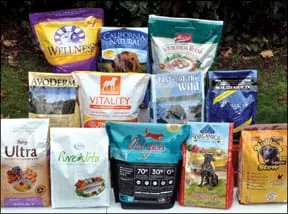By every measure, the “natural and holistic” segment of the U.S. pet food market has enjoyed spectacular growth over the past decade – far greater than that of the pet food market as a whole. As one example, figures supplied to Petfood Industry magazine by industry analyst Packaged Facts show that the U.S. pet food market as a whole grew at a rate of 5.3 percent from 2003 to 2007, but the “natural foods” segment of that market grew 24.6 percent in the same span. And the “organic” segment experienced an astounding 48.1 percent growth rate.

288
A rising tide lifts all boats. And the success of the “natural and holistic” niche has been lifting the quality of offerings from the pet food industry as a whole. What pet food company owner or wouldn’t look at those numbers and immediately ask his employees to run out and concoct a product to compete in the “natural foods” niche?
The answer is, apparently, none, because just about every pet food maker has rolled out products claiming to be natural and/or holistic, containing organic and/or “wild” ingredients. That should be a good thing, right? Well, yes. And no!
It’s good because there are more and more better-quality foods available to dog owners. Today, the medium-quality foods have gotten better, and what we would consider true “premium” foods are much more widely available than they used to. They now appear regularly in most independent pet supply stores (historically the leaders in finding and promoting the healthiest products) but also in chain retail stores. In 1998, the year Whole Dog Journal was launched, the “big box” pet supply stores had little to offer owners who were looking for the very best-quality dog foods; today, they carry a wide variety of good foods. A few premium foods even appear in higher-end supermarkets!
On the other hand, so do what I’d call “posers” – the catch-up products churned out by the pet food industry giants in an effort to grab some of that “natural and holistic” market share. These products beg the question: Can corporate titans produce foods of the same quality as the little “boutique” companies that were founded on the concept of producing only the very best, healthiest dog foods?
I’d like to quickly dismiss the idea that any of the giants – Iams and Eukanuba, Purina, Science Diet, et. al. – could possibly make dry dog foods that are as good as the foods that have a regular presence on Whole Dog Journal’s “approved foods” list. The fact is, though, of course they could; they have all the resources needed to do so. They could bury most of the competition in the “natural and holistic” niche . . . if they followed through and used only the same high-quality ingredients typically used by the smaller, boutique brands. But they generally stop short – perhaps because they are unaccustomed to paying a lot for their raw materials, or marketing the products at a correspondingly high sales price?
Advantages and disadvantages of scale
The sheer size of a company doesn’t disqualify it from making truly premium foods (although we’ve been accused, falsely, we think, of promoting that idea). The corporate giants have some amazing advantages over the boutique food producers; they really shine at some aspects of food production – not incidentally, the very tasks that the smaller companies don’t always do very well.
As an important example, economies of scale enable the giants to conduct more frequent and more thorough quality and safety tests, to produce larger batches with greater consistency (fewer production glitches), retain better-paid and more highly trained employees – in short, to do a better job of producing safe, consistent products.
The giants also employ legions of brilliant food scientists, who are able to conduct incredible research into animal nutrition and health. Their products are better-researched and more thoroughly tested than their small competitors’ products – some of which were dreamed up by people with very little education or experience in animal nutrition.
But for all that, what the giants can’t seem to do – yet – is to formulate foods using the high-quality ingredients that the “little guys” are using. Many of the companies whose products are on our “approved foods” list buy their ingredients from local farms, ranches, and fishermen. Most source their ingredients themselves; they don’t leave procurement to their co-manufacturing partners or ingredient brokers, so they can be absolutely certain of the origin and quality of every ingredient used in their products. We think that the recalls of 2007 proved the critical nature of this sort of rigor.
It’s the ingredients
Nutrition experts don’t agree on everything, but one thing they generally concede to be true is that all animals enjoy the best health when given a balanced and varying diet of fresh, species-appropriate foods. They also generally agree that highly processed foods are not as healthy as lightly processed foods; some of nature’s value is always lost to oxidation, heat, pressure, and chemical interactions. Dry food (kibble) is the most processed type of food available to dog owners – but foods that are made with already highly processed (and sometimes, as a result, rather aged) ingredients are at a big disadvantage, compared to those that are made with fresh, whole ingredients.
It’s bad enough that most pet foods are made with meats and fats that are far inferior in quality to what’s known as “edible” (“human quality”) meats and fats. I’m talking about the things that may go into pet food that cannot go into human-edible products, like meats that don’t pass inspection and meat from animals that are dead before they can be slaughtered. Also, the handling and storage of ingredients that are diverted at the processing plant for “non-edible use” – in other words, for pet food – is far inferior to the processes used for “edible” ingredients. (In short, edible ingredients are kept clean and cold all the way through the food production chain; pet food ingredients are not.)
We’d certainly like to identify and promote only those products that contain “edible” meat sources. Unfortunately for consumers, there is no reliable way to do this. A company can say they use only edible ingredients, but few (none?) can legally prove it; according to Federal law, any ingredient that is present at a pet food plant is, by definition, “inedible.” So, if a truckload of fresh, refrigerated, wholesome chicken headed to your local supermarket pulls over at a pet food plant, and opens the back door of the truck, the contents of the truck are now “inedible” by law. It’s perfectly fine food, but the food maker is not legally permitted to say that it’s edible.
Only human-food plants – inspected by the USDA – can legally claim they use edible meats, and this is only if not one single inedible ingredient is on the premises.
Barring the ability to identify the companies that use edible ingredients, we suggest that you look for other evidence of quality. Will – or can – the company identify the sources of its ingredients? Are the ingredients unprocessed, or lightly processed? Or are they a waste product from the production of human food?
We don’t have studies to prove it, but we regard it as a founding principle of holistic healthcare: A diet made with fresh, whole, species-appropriate ingredients (think animal proteins, rather than plant proteins) is far healthier than one made with cheap fats discarded from restaurants, inexpensive carbohydrates produced as waste from the brewing industry, and plant proteins such as corn gluten meal.
Not that many years ago, the pet food industry became a convenient place for the human food industry to dispose of its waste products, without paying landfill fees. Pet food makers were pleased to have ready supplies of inexpensive ingredients. Owners were happy to buy something to feed their dogs that was so convenient to store and feed. Dogs, as they have been for centuries, were thrilled to get whatever their humans would share with them. The ingredients panel on a bag of dog food was rarely considered.
But today, we’re putting the pieces together: diet affects health. Consumers are responding to the positive changes they’ve seen in their dogs on improved diets, and many companies are responding to consumers’ feedback. But the only way to distinguish the passionate, committed, knowledgeable food makers from the posers is to start looking at, and understanding, the ingredients panel.
Representative “top foods”
Here is our “approved dry foods” list for 2010. All these products meet our selection criteria – including our newest criterion, that the company discloses the name and location of its manufacturers. It’s by no means a list of the only good foods on the market; it’s meant as a fair representation of the good-quality foods that are available. Rest assured that any food that you find that meets our selection criteria is just as good as any of the foods on our list.
What if your favorite dog foods don’t meet our selection criteria? It’s up to you. If you have been feeding what we would consider to be low-quality foods to your dog, and she looks and appears to feel great, good for you! She’s one of those genetically lucky animals who can spin straw into gold, digestively speaking. But if she has allergies, chronic diarrhea, recurrent ear infections, or a poor coat, we’d recommend that you upgrade.
Note that we’ve listed the foods alphabetically, by the name of their manufacturers. Some companies make several product lines. We’ve listed each product line that meets our selection criteria from each manufacturer. We’ve also highlighted one product from each company as a representative, to show what sort of ingredients and macro-nutrient levels (protein, fat, fiber, and moisture) are typically found in that maker’s foods. Be aware that some companies offer dozens of different products with varying nutrient levels and ingredients. Check the company’s website or call its toll-free phone number to get information about its other varieties.








